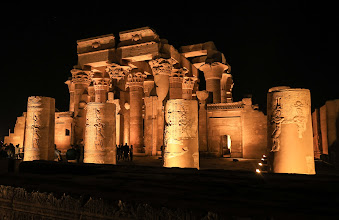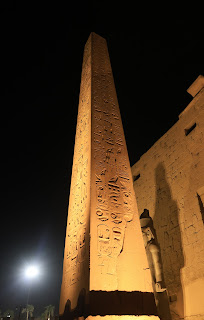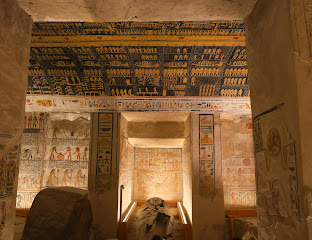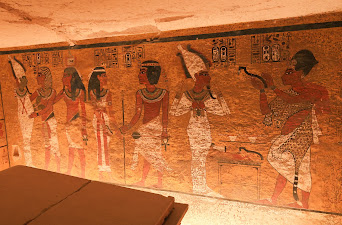Egypt (Part II)
Aswan and Luxor
Jan 2nd - Jan 6th, 2025
This is the second part of our Egypt trip. After 4 days in Cairo, we flew down south to Aswan, which is a short 1.5 hour flight.
Aswan
After the bustling chaos, crazy traffic and air pollution of Cairo, arriving in Aswan seems like you've entered a different, peaceful and scenic world. Aswan is located along the Nile, surrounded by huge sand dunes and picturesque palm-fringed islands. You see many feluccas, which are the traditional sailboats, gliding along the dark blue waters of the river.
We had one night by ourselves here, before the start of our river cruise. We stayed in the beautiful Mövenpick hotel, which is located on Elephantine Island. Just before sunset we headed out, and were persuaded by an enthusiastic captain to take his small boat upriver and watched a gorgeous sunset from the deck.
The boat dropped us off at the other side of town at the famous Old Cataract Hotel, which is a beautiful colonial era hotel, built in 1899. The hotel has accommodated many kings, queens and heads of state over the years. It is also the place where Agatha Christie stayed in the 1930s, when she wrote "Death on the Nile". We enjoyed Agatha Christie's favorite cocktail and a wonderful dinner on the terrace with Guillaume, a French solo traveler we met in front of our hotel earlier that day.
The next morning we were picked up from the pier at the hotel and transferred to the cruise ship, where we settled in our small but fairly nice cabin, which would be our home for the next three days.
You can take the boat trip between Aswan and Luxor in either direction. They typically take 3 nights from Aswan to Luxor, which is downriver, and four nights the other way. The river boats all look pretty similar, but there are differences in the level of luxury on board. I had booked ours through TourRadar.com, which was a nice, but not too luxurious or expensive cruise. The boat featured 75 cabins and accommodated approximately 150 guests, divided among various tour groups. Our group (run by Holiday in Egypt) had around 25 people. After settling in we were picked up by bus for our first excursion to Philae Temple.
Philae Temple
The Temple of Philae, located on an island in the river near Aswan, is one of Egypt’s best preserved and historically significant temples. Originally, the temple stood on Philae Island, but due to the construction of the Aswan High Dam in the 1960s, the site was at risk of being submerged under the waters of Lake Nasser. In a remarkable UNESCO-led rescue project, the entire temple complex was carefully dismantled and relocated to its current location on Agilkia Island, which sits in the lake between the Aswan High and Low dams.
The main parts of the Temple of Philae were built during the Ptolemaic period (305 to 30 BC), with some later additions by the Romans. The primary temple features a grand pylon with reliefs depicting the Ptolemaic pharaohs making offerings to the gods.
The interior of the temple is completely covered in fine reliefs, something we will later see in almost all of the Egyptian temples. Most of the reliefs tell the story of Isis, her husband Osiris, and their son Horus, which are all important gods in Egyptian mythology.
Dedicated primarily to Isis, the goddess of motherhood, magic, and fertility, Philae was one of the last active centers of ancient Egyptian religion before the spread of Christianity. During the Christian era, parts of the temple were converted into a Coptic church, with some ancient carvings defaced to remove pagan imagery.
We had one night by ourselves here, before the start of our river cruise. We stayed in the beautiful Mövenpick hotel, which is located on Elephantine Island. Just before sunset we headed out, and were persuaded by an enthusiastic captain to take his small boat upriver and watched a gorgeous sunset from the deck.
The boat dropped us off at the other side of town at the famous Old Cataract Hotel, which is a beautiful colonial era hotel, built in 1899. The hotel has accommodated many kings, queens and heads of state over the years. It is also the place where Agatha Christie stayed in the 1930s, when she wrote "Death on the Nile". We enjoyed Agatha Christie's favorite cocktail and a wonderful dinner on the terrace with Guillaume, a French solo traveler we met in front of our hotel earlier that day.
The next morning we were picked up from the pier at the hotel and transferred to the cruise ship, where we settled in our small but fairly nice cabin, which would be our home for the next three days.
You can take the boat trip between Aswan and Luxor in either direction. They typically take 3 nights from Aswan to Luxor, which is downriver, and four nights the other way. The river boats all look pretty similar, but there are differences in the level of luxury on board. I had booked ours through TourRadar.com, which was a nice, but not too luxurious or expensive cruise. The boat featured 75 cabins and accommodated approximately 150 guests, divided among various tour groups. Our group (run by Holiday in Egypt) had around 25 people. After settling in we were picked up by bus for our first excursion to Philae Temple.
Philae Temple
The Temple of Philae, located on an island in the river near Aswan, is one of Egypt’s best preserved and historically significant temples. Originally, the temple stood on Philae Island, but due to the construction of the Aswan High Dam in the 1960s, the site was at risk of being submerged under the waters of Lake Nasser. In a remarkable UNESCO-led rescue project, the entire temple complex was carefully dismantled and relocated to its current location on Agilkia Island, which sits in the lake between the Aswan High and Low dams.
The main parts of the Temple of Philae were built during the Ptolemaic period (305 to 30 BC), with some later additions by the Romans. The primary temple features a grand pylon with reliefs depicting the Ptolemaic pharaohs making offerings to the gods.
The interior of the temple is completely covered in fine reliefs, something we will later see in almost all of the Egyptian temples. Most of the reliefs tell the story of Isis, her husband Osiris, and their son Horus, which are all important gods in Egyptian mythology.
Dedicated primarily to Isis, the goddess of motherhood, magic, and fertility, Philae was one of the last active centers of ancient Egyptian religion before the spread of Christianity. During the Christian era, parts of the temple were converted into a Coptic church, with some ancient carvings defaced to remove pagan imagery.
After returning to the boat, we joined an optional excursion to the Nubian village of Gharb Soheil, situated on the west bank of the Nile, just outside Aswan.
The Nubians, an indigenous people of southern Egypt and northern Sudan, have a rich history that dates back thousands of years. During much of ancient Egyptian history, the Nubian kingdom of Kush was at times part of the Egyptian empire, but more often a powerful adversary of Egypt.
The Nubian culture is quite distinct from Egyptian culture, and they have their own language, which is still widely spoken but has no written form. After the construction of the Aswan High Dam in the 1960s, many Nubians were displaced from their ancestral lands along the Nile, but they have managed to preserve their identity and their culture continues to thrive in the villages around Aswan. Nubian villages stand out mainly due to their distinct architecture and very colorful houses.
Many of the Nubian households keep small pet crocodiles in their homes, which are supposed to bring luck to the family.
We took a bumpy ride in a tuk-tuk to the top of the mountain above the village for these amazing sunset views over Aswan and its many islands. The juxtaposition of the green lush islands and the deep blue waters of the Nile against the sand dunes of the Sahara desert gives this an almost otherworldly feel. (You can also see the huge high dam in the background in the second picture here.)
Abu Simbel
During our first night on the boat, we didn't actually leave the dock in Aswan. We had an optional trip very early the next morning to Abu Simbel by bus. The bus left Aswan at 4:00 am for the 4 hour drive to the very south of Egypt, near the border with Sudan. It is possible to do the day trip from Aswan to Abu Simbel by plane, however our tour operator only offered the trip by bus. But no matter how you get there, it is worth it. Abu Simbel is, simply put, one of the greatest human creations in the ancient world - a truly astounding monument.
The temple was carved out of the rock in the 13th century BC under the reign of King Ramses II. It took 20 years to complete. Over the millennia, the temple had become entirely covered by sand dunes, and it was only rediscovered in the early 19th century by German and Italian explorers. Starting in 1968, the entire temple was moved piece by piece from its original location, which was about to be inundated by the rising waters of Lake Nasser, after the construction of the Aswan High Dam. This was a massive engineering project led by UNESCO, and it took 8 years of painstaking work to disassemble and rebuilt the whole complex on higher ground.
Considered to be one of the greatest and most powerful rulers of Ancient Egypt, Ramses II was the third king of the 19th dynasty. He reigned for 66 years. He also greatly expanded the empire's territory, when he conquered Syria and and parts of Nubia. All four of the monumental statues at the entrance depict Ramses II in different outfits. The temple is considered the culmination of the personality cult, Ramses II had created around himself.
The first hall after entering is flanked by these huge standing sculptures on either side.
Every inch of the walls of the large interior space contains incredibly rich and detailed rock carvings. And the entire interior is carved in scene of the life and military victories of Ramses II. It is simply beyond imagination to try to contemplate the amount of planning, design and man-hours that would have gone into chiselling all of this out of a mountain by hand nearly 3,300 years ago.
One of the most remarkable features of the temple is its alignment with the sun. On February 22 and October 22, the rising sun exactly illuminates the inner sanctuary, lighting up the statues of the gods and Ramses II.
The whole complex actually consists of two grand temples carved into the cliffs. The smaller of the two is dedicated to Ramses II favorite wife Nefertari.
Even among the numerous and amazing ancient sites in Egypt, Abu Simbel stands out uniquely. It is truly one of the most awe-inspiring monuments I had ever seen. We spent about 2 hours exploring the two temples, before getting on the bus again for the long drive back to Aswan, which we reached at around 2:00 pm, just in time for the boat leave the pier and start sailing downriver.
Kom Ombo
Our first stop was going to be Kom Ombo Temple, located on the eastern bank of the river about 45 kilometers north of Aswan. It was already completely dark, when we reached the temple, but that did not diminish the experience in any way. Quite the opposite, the beautiful lighting gave it an eerie feeling and brought out the details of the extensive carvings even better.
Similar to Philae temple, Kom Ombo is from the Greco-Roman period, built circa 180–47 BCE during the Ptolemaic dynasty, with a few later additions by the Romans. It is dedicated to two gods - Sobek, the crocodile-headed god of fertility, and Horus, the falcon-headed sky god.
The temple features richly carved reliefs and inscriptions, in the artistic style of Ancient Egypt with Greco-Roman influences. The Ptolemaic pharaohs were keen to represent their rule as a continuation of Egyptian dynasties and not emphasize their Macedonian origins.
One very noteworthy relief on the inner walls shows intricate depictions of sophisticated surgical instruments, which suggests a high degree of medical knowledge at the time.
There is a small museum attached to the temple, which displays many interesting artefacts, including a large number of mummified Nile crocodiles, which were considered sacred animals.
Edfu
After another comfortable night on the boat, we got up very early to visit Edfu Temple before sunrise. We started lining up at 5:30 am at the gates together with probably a couple of thousand other people to wait for the 6:00 am opening. It was still dark when we entered this amazing place.
The Temple of Edfu, also built during the Ptolemaic period (237 - 57 BC) and dedicated to the god Horus (which is the one with the falcon head) is one of the best-preserved temples in Egypt. It is fronted by a monumental facade adorned with huge carvings showing Horus and the Pharaoh Ptolemy VIII striking down enemies. After passing through the entrance, you reach a large open courtyard lined by enormous columns.
Edfu Temple is particularly famous for its well-preserved carvings and inscriptions, which show mythological battles and sacred festivals.
In the centre of the whole complex is a narrow chamber with a holiest item in the temple, a small sculpture of the god Horus.
The main reason the temple remained so well preserved is because it was completely buried under sand for centuries, and only rediscovered and excavated in the 19th century. We returned to the boat just as the sunrise began to illuminate the huge pylons, a magical sight.
After visiting Edfu in the early morning the boat continued downriver towards Luxor. We passed beautiful and tranquil landscapes of lush green fields and palm trees with huge sand dunes in the background.
Nile cruises are a very popular activity, and the primary way to visit this area of Egypt. Consequently, there are a large number of river cruise ships parading in a long line down the river. At some of the docking areas, so many boats were docked next to each other, that we had to walk through five other boats before getting to the pier.
About 50 kilometers before Luxor, there is a major obstacle, which slows down the boat trips significantly - the Esna locks. The Esna dam manages the waterflow between the lower and upper Nile and creates a difference in water levels of about 8 to 10 meters. The Esna locks allow the large river boats to be lifted and lowered to pass through the dam, but there are only two narrow channels with space for only two boats at a time. So the wait is usually several hours. While we waited we were entertained by the souvenir and textile traders in small rowing boats, who throw their wares up to the cabin windows and balconies with impressive accuracy, in order to entice people to buy things.
We reached the city of Luxor, which was the site of the ancient Egyptian capital of Thebes. Luxor is probably the most important city historically and has many of the most impressive monuments in all of Egypt. We started our sightseeing here at one of Egypt's greatest temples, the astounding Temple of Luxor.
Luxor Temple
Luxor Temple was began by the 18th dynasty king Amenhotep III, who was perhaps the greatest builder among all the kings. His reign of 37 years (1390 - 1353 BC), was one of the few periods in Egyptian history without a major war, as he managed relationships with the neighboring empires through diplomacy and strategic marriage, instead of military conflict. Amenhotep's almost 4 decades on the throne are considered one of the golden ages of Egypt, in which he elevated the god worship of the king to new heights, and built himself more temples, statues and other monumental structures than any other king.
While Amenhotep III was the pharaoh, who began construction of the temple, several subsequent kings of the New Kingdom made significant changes and additions to it. Ramses II (1279–1213 BCE) greatly expanded the temple, and erected giant statues of himself at the entrance. He also placed a pair of obelisks in front of the pylon. However, only one remains here, as its twin was gifted by the Egyptian government to France, and it now stands in the center of the Place de la Concorde in Paris.
When you cross into the first courtyard you are overwhelmed with huge columns and more monumental statues, also built by Ramses II and other rulers, such as Tutankhamun and Horemheb. More additions were made much later during the Greco-Roman period. There is even an inscription by Alexander the Great in a sanctuary within the temple.
Unlike most other major temples, which were primarily dedicated to a specific god, Luxor Temple was associated with the rejuvenation of kingship and played a central role in the annual Opet Festival. During the festival the statue of Amun was carried from Karnak to Luxor in a grand procession, symbolizing the divine relationship between the pharaoh and the gods.
In front of the temple is the Avenue of the Sphinx, which was once 3 kilometers long connecting Luxor Temple to Karnak Temple.
We spent our last night on the boat anchored at the pier in Luxor, and then headed out early the next morning for another full day of amazing sites. We crossed the river to the west bank of Luxor and first stopped at the famous Colossi of Memnon.
The Colossi of Memnon are two 18 meter high seated stone statues. They depict Amenhotep III and once flanked the entrance to his mortuary temple. The two enormous statues were carved around 1350 BC and likely transported from quarries near Cairo, over 600 kilometers away.
Hatshepsut's Palace
We continued our tour further west into the mountains to visit a very different temple, than any we had seen so far. The beautifully restored Hatshepsut's Palace, was the mortuary temple of Queen Hatshepsut (18th Dynasty, around 1479–1458 BC). The temple is considered to be one of the most remarkable architectural achievements of ancient Egypt, with its three perfectly symmetric terraces built into the side of the cliffs.
Each of the terraces is fronted by colonnades and lined by statues.
Queen Hatshepsut is one of the most fascinating and influential figures in Egyptian history. She initially served as regent for her stepson and nephew, Thutmose III, who was too young to rule when his father died. However, within a few years, Hatshepsut rose to take the full powers of a pharaoh. To justify her authority, statues of Hatshepsut often show her with distinctly male features or even a false beard.
Her reign was a period of peace and prosperity, and she erected many monumental buildings. But despite her achievements, later pharaohs, particularly her stepson Thutmose III, tried to erase the memory of Egypt's powerful female ruler, by removing her name from all official records and by defacing many of the images in the temple. Fortunately later scholars were able to rediscover her story and restore many of the beautiful reliefs, which depict important events from Hatshepsut’s reign.
The Valley of the Kings
The Valley of the Kings is one of the highlights of any trip to Egypt and one of the most important archeological sites in the world. Over a period of about 500 years, this valley served as the burial ground of the pharaohs and other nobles of the New Kingdom (around 1550 to 1070 BC).
The valley contains over 60 tombs of varying sizes and complexity. Many the most famous kings of the 18th, 19th and 20th dynasty were buried here. The tombs are open for tourists on a rotating basis, to ensure their preservation. There are several different tickets you can buy. The general ticket gives you access to about 4 or 5 tombs, and then there are extra tickets you can buy online to see additional tombs. Depending on how much time you have, it is absolutely worth it to buy as many of the additional tickets as possible, as some of the most elaborate and largest tombs require these extra tickets. We bought them all, and managed to visit every possible tomb in the one hour we were given by our guide. It was a little hectic, running from one to the next, but it was absolutely worth it. These are just some of the photos I took, of the brightly colored and unbelievably well preserved wall paintings you find deep underground.
Some, like the grand tomb of Ramses VI, have long corridors and several decorated chambers, where every inch of wall space is covered in intricate hieroglyphs and depictions of the pharaoh’s journey to the afterlife.
The most expensive of the extra tickets is for the tomb of Seti I, but there is a good reason for that. With a total length of 174 meters, the tomb is one of the deepest and most richly decorated of them all.
There is one fascinating room in the tomb of Seti I, which shows only drawings. Typically, work on the tombs stopped, when the king died. So in this case they didn't have enough time to finish the painting, which leaves just the outlines of the figures.
The Valley of the Kings is of course a UNESCO World Heritage Site. And despite the fact that this is one of the most explored archeological sites in the world, new discoveries are still being made here.
Unlike the pyramids of the Old Kingdom, during this period the tombs of the kings were carved deep into the desert cliffs, and their entrances were hidden to protect them from grave robbers. However, most of them were still looted during ancient times, or even reused by later kings, but with one spectacular exception: the tomb of Tutankhamun, which was discovered almost perfectly intact in 1922 by Howard Carter. Because of the kings early death at the age of 18, his tomb is one of the smallest and least elaborate ones in the valley.
While all of the treasures from King Tut's tomb are in the Egyptian Museum in Cairo, his mummy was kept here underground, where it has been lying for 3,348 years.
Visiting the tombs in the Valley of the Kings was a truly unforgettable experience. I think these masterpieces rank among the greatest artistic achievements in the world, and they have given us incredible insight into the history and grandeur of Ancient Egypt.
Karnak Temple
After lunch and a stop at a workshop for carving alabaster, we visited our final monument on the trip, the enormous Karnak Temple. Located just north of Luxor Temple, Karnak is the largest religious complex ever built. Covering over 200 acres, the temple was the center of worship for Amun-Ra, the chief god of Thebes. Construction of the temple began during the Middle Kingdom (around 1,900 BC) and continued for almost 2,000 years, with contributions and extensions from many of the most significant pharaohs, including Hatshepsut, Seti I, and Ramses II.
The temple is not as well preserved as for instance Luxor or Edfu, but its sheer size is still very impressive. The complex is famous for its Great Hypostyle Hall, which is a huge space filled with a forest of 134 massive columns towering over 20 meters high. Each of them is intricately carved with hieroglyphs.
Karnak also features several obelisks, sacred lakes and numerous temple buildings.
Just behind one of the large walls at Karnak temple you can find an earth and brick mound piled up against the wall. This is very interesting, since it confirms the theory, that all of the Egyptian temples and pyramids were constructed using earth ramps instead of scaffoldings or other methods, that had been suggested over the years.
Rosie and I said good bye to the rest of our group here at Karnak Temple, and we then finished our last day in Egypt with a lovely afternoon tea at the beautiful Winter Palace Luxor Hotel.
We had a late evening flight from Luxor to Cairo, where we spent our last night in the airport hotel, before returning to Munich on a direct flight from Cairo the next morning. I expected Egypt to be amazing, but it still exceeded all of my highest expectations. It is one of the cradles of human civilization and a truly spectacular country to visit.




















































































Every time I read it, it feels like I am in Egypt again. Thank you for spending hours restoring good knowledge and memories.
ReplyDelete